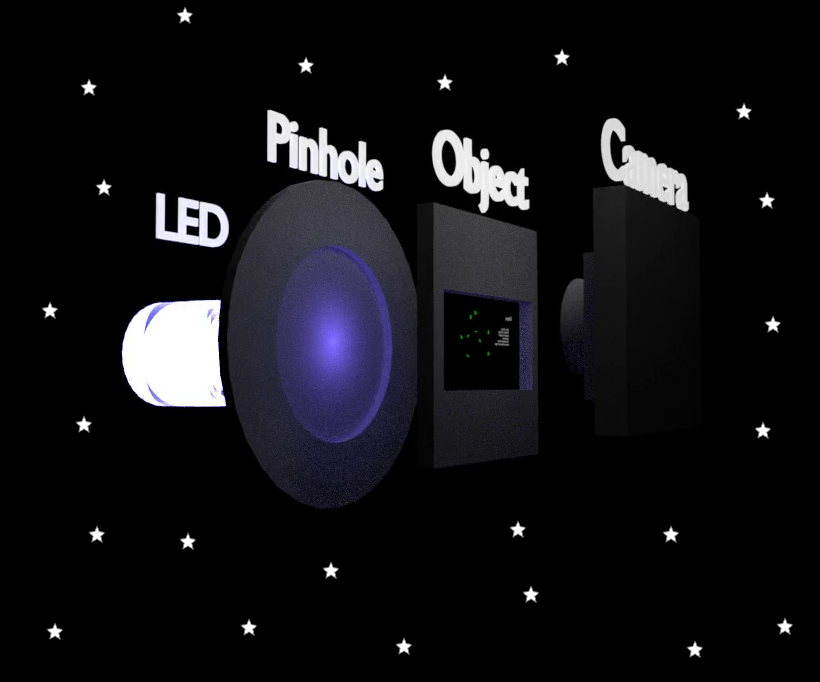| Line 60: | Line 60: | ||
<!-- One --> | <!-- One --> | ||
| − | + | <section id="one"> | |
<div class="container"> | <div class="container"> | ||
<header class="major"> | <header class="major"> | ||
| − | <h2> | + | <h2>Digital Inline Holography Microscopy and its Benefits for You</h2> |
</header> | </header> | ||
| − | + | <p style="font-size:20px"> | |
| + | <div class="post-it"> | ||
| + | |||
| + | |||
| + | The motivation of building a DIHM comes with the 'digital lens' functionality of the 3D reconstruction algorithm. Compared with digital holographic microscopy, 3D imaging using classical optics setup is also possible. However, the practice of mechanically recording wavefronts at slightly different distances near the object for 3D imaging would significantly raise up the setup complexity, let alone the high expenses on optical lenses. On the other hand, DIHM uses reconstruction algorithm as a virtual digital lens, to reconstruct the wavefront holograms at various distances, thus offering a cost efficient solution with a much simpler setup, enabling submicron resolution with 3D imaging. | ||
</div> | </div> | ||
| − | </section> | + | <br> |
| + | <center> | ||
| + | <a href="tech/hardware"><img class="HoverBorder" src="https://static.igem.org/mediawiki/2017/5/51/TechMainHard.png" alt="Picture of our hardware"></a><a href="tech/software"><img class="HoverBorder" src="https://static.igem.org/mediawiki/2017/9/99/T--TU_Darmstadt--holopyguy.png" alt="Picture of software"></a> | ||
| + | </center> | ||
| + | <br> | ||
| + | </p> | ||
| + | </div> | ||
| + | </section> | ||
| + | |||
| + | |||
<section id="two"><div class="container"> | <section id="two"><div class="container"> | ||
<h3>Submenu 1 id "two"</h3> | <h3>Submenu 1 id "two"</h3> | ||
Revision as of 17:50, 20 October 2017

ChiTUcare
Digital Inline Holography Microscopy and its Benefits for You
The motivation of building a DIHM comes with the 'digital lens' functionality of the 3D reconstruction algorithm. Compared with digital holographic microscopy, 3D imaging using classical optics setup is also possible. However, the practice of mechanically recording wavefronts at slightly different distances near the object for 3D imaging would significantly raise up the setup complexity, let alone the high expenses on optical lenses. On the other hand, DIHM uses reconstruction algorithm as a virtual digital lens, to reconstruct the wavefront holograms at various distances, thus offering a cost efficient solution with a much simpler setup, enabling submicron resolution with 3D imaging.


Submenu 1 id "two"
Abstract: Faucibus sed lobortis aliquam lorem blandit. Lorem eu nunc metus col. Commodo id in arcu ante lorem ipsum sed accumsan erat praesent faucibus commodo ac mi lacus. Adipiscing mi ac commodo. Vis aliquet tortor ultricies non ante erat nunc integer eu ante ornare amet commetus vestibulum blandit integer in curae ac faucibus integer non. Adipiscing cubilia elementum.
$$ \begin{equation} (\hat{T}_{e} + \hat{T}_{N} + \hat{V}_{e} + \hat{V}_{N} + \hat{V}_{eN})\Psi=i \hbar \frac{\partial}{\partial t}\Psi \label{Schrödinger} \end{equation}$$


